#kim mckamy
Photo










Evil Laugh (1986)
#evil laugh#dominick brascia#kim mckamy#ashlyn gere#myles o'brien#jerold pearson#horror#slasher#80s horror#80s slasher#women in horror#final girl#scream queen#halloween 2020#slasher movies#1980s horror#1980s slasher#horrorstills
257 notes
·
View notes
Photo

Creepozoids (1987)
#creepozoids#1987#david decoteau#linnea quigley#ken abraham#kim mckamy#michael aranda#1980s#sci fi#horror#film
12 notes
·
View notes
Text
The rise of Empire as a low budget producer with their “Beyond Infinity” video line resembles the start-up of AIP during the drive-in boom of the late ’50s, when a definite market existed for a certain product: films for the teenage audience, the wilder and more outrageous the better. The drive-ins “made” American-International Pictures, and like AIP, the VCR spurred Empire and other companies to produce films for a new market. But-having seen most of Empire’s Beyond Infinity offerings to date-one thing is obvious: unlike AIP, Empire lacks the creative genius of a low-budget auteur like Roger Corman. Imagination is not necessarily related to a film’s budget; low-budget films could be original, entertaining, and thought-provoking. But, Beyond Infinity’s releases thus far have proved to be inane, routine, and boring.
The Empire films follow a standard pattern: an exploitative, campy title; garish ad art; scripts which slavishly follow tried-and true formulas; varying amounts of nudity, gore effects, and juvenile humor. Of course, these traits apply equally well to the offerings of Empire’s competitors, particularly Troma Pictures, although Beyond Infinity product has a California pastel plasticity as opposed to Troma’s sleazy New York sheen. The fact that there is little of real interest to be found in any Beyond Infinity film certainly contributed to the commercial downfall of Empire and its video arm. Though the films themselves may not be completely devoid of entertainment value, most of the creativity seems to have gone into dreaming up the exploitable titles.
Dave DeCoteau, director of several projects released by Empire’s “Beyond Infinity” video label, pegged the fall of Band’s Empire to “the market place. It’s changed,” said DeCoteau. “There was a time that horror and fantasy fans saw just about anything that was made available on video. These days, quality prevails among genre movies, including films that are squarely made for direct-to-video release. You have to make the best movie you can and spend the money to do it right. If someone tries to pawn off a piece of shit, they’re shown the door.”
Reflecting on his three picture stint at Empire, DeCoteau said, “Charlie Band’s company was the young filmmaker’s first stop after college. There was a lot of experimentation as young people learned to work with low budgets. As a result, Empire wound up with a lot of product that was not all that wonderful. The company has been called the Sausage Factory of the Cinema. But you can’t keep making sausages, one after the other, sometimes a steak falls off the conveyor belt. Sometimes that steak is a picture like Stuart Gordon’s RE-ANIMATOR. There’s also a lot of sausages. Creepozoids is one of those sausages … but I’m learning.”
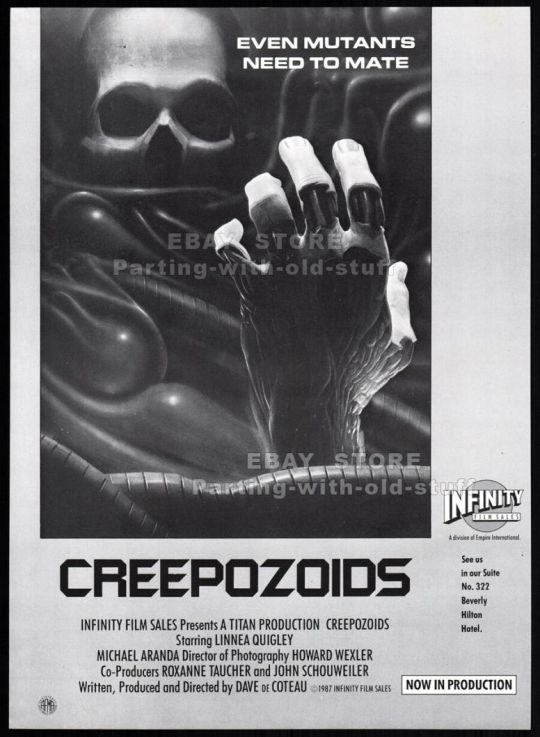
DeCoteau tied Empire’s loss of revenue to an aborted video output deal with New World Pictures, announced in August 1987, as the event which triggered Empire’s collapse. Over a two-year period, New World Video was to release five Empire titles, including Prison (1987), Cellar Dweller (1988), Buy & Cell (1988), Pulse Pounders (1988), and APPARATUS. “Empire made four of the pictures back to back,” said DeCoteau. “But because of the 1987 stock market crash, the deal between Empire and New World seemed to change; New World refused to pick up all of the Empire films as quickly as planned. They eventually released two of the films: PRISON, which had a limited theatrical run, and also CELLAR DWELLER, but the others are still being worked on.” Empire was purchased last May by Epic Pictures, a European financial consortium supervised by Eduard Sarlui, owner of Transworld Entertainment. “Basically, Empire and Transworld are owned by the same company,” said DeCoteau of the Epic umbrella. “Epic Pictures is finishing all the movies that Charlie [Band] started, which is a good dozen … ARENA, CATACOMBS, DOWN UNDER, SPELLCASTER, ROBOJOX.

DeCoteau, trained as a production assistant on films as diverse as ANGEL and Ken Russell’s CRIMES OF PASSION, made his debut as a producer-director with Empire on DREAMANIAC (1986), released on the company’s Wizard video label, distributed by Vestron. “I started pre-producing it as a picture called SUCCUBUS,” said DeCoteau. “Helen Robinson, who wrote the script knew the head of creative development at Empire Pictures, Debra Dion. Helen mentioned to Debi that she’d like to write a movie for Empire. Debi asked for a sample of her work and Helen gave her the SUCCUBUS script.” Empire, impressed with Robinson’s work, offered to purchase the screenplay; Robinson declined, insisting that De Coteau already owned it.

“Empire reacted by wanting to get involved in the production,” said DeCoteau. “Only four days before we were scheduled to start principal photography, I met Charlie Band, president of Empire Pictures.” Band not only doubled the movie’s original budget to $60,000, but vowed to reimburse DeCoteau for his personal investment “upon completion of principal photography.”
Wrapped in 15 days, the $70,000 movie was filmed in the abandoned studio of Hustler photographer Suze Randall. The film a blend of critters, slime and skin reunited DeCoteau with Kim McKamy, who made her film debut in DREAMANIAC. “Ironically,” remembers the director, “Kim refused to do any nudity. She was very shy and an all around sweet person.” McKamy later transformed herself into X-rated starlet Ashlyn Gere (aka Kim Patton), whose films-SORORITY SEX KITTENS, BUSH PILOTS, LAID IN HEAVEN—were about as demure as their titles.
“During a screening of the dailies,” recalls DeCoteau, “Charlie Band looked at me and held up ten fingers. I asked what it meant and he said, ‘Ten picture deal.’ I nearly fell out of my chair. We went upstairs, he drew up a contract and opened a $100 bottle of Dom Perignon champagne and we drank it out of Dixie cups. The next day, the cover of Daily Variety read in big bold letters, ‘CHV 10 PIC PACK DEAL WITH EMPIRE.’ [Cinema Home Video partner] John Schouweiler and I went crazy. I was only 25 years-old!
“Whenever Charles had big picture deals, I would be the slave to the market and make the smaller horror, erotic, high concept T&A movies…whatever was hot. I rarely did an ‘A’ movie for him, but I was constantly working.”
This slideshow requires JavaScript.
DeCoteau’s subsequent project for Empire was CREEPOZOIDS, produced as a Beyond Infinity release for $169,000. “We wanted to do our own version of ALIENS,” said DeCoteau. “So we put together a picture called MUTANT SPAWN 2000 and I was developing a picture called CREEPOZOIDS, which was actually a hybrid of GREMLINS and GHOULIES. We just flip flopped the titles, referring to the ALIENS rip-off as CREEPOZOIDS.”
“I first met David when he worked as a caterer on a short film called THE CAYTONSVILLE ELEVEN,” says Linnea Quigley. “I was excited to work with him. There’s no huge ‘I’m a director’ ego. He’s not into himself. He’s a good businessman and he talks about stuff besides movies. He even had vegetarian food for me every day, and warm Sparklett’s water for my lusty shower scene in CREEPOZOIDS.”
This slideshow requires JavaScript.
DeCoteau not only directed, but also functioned as the movie’s co producer and co writer. In spite of its diminutive budget, CREEPOZOIDS was theatrically released on a double-bill with SLAVE GIRLS FROM BEYOND INFINITY. The twin bill was released by Urban Classics, the theatrical arm of Empire’s Beyond Infinity video line. CREEPOZOIDS made the transition to video a few months later in January ’88, selling 15,000 tapes for Empire, according to DeCoteau.

DeCoteau’s next film for Empire, THE IMP, was limited to a shooting schedule of two weeks. Budgeted at $190,000, with ten per cent in above the line costs for DeCoteau’s expenses as director and co-producer, locations were selected outside of Los Angeles to conserve funds. “Los Angeles is the most expensive city in the world to make a movie,” said DeCoteau, “because of the permits, location costs, and everything like that. It’s hard to rent a basic middle-class tract house in the Valley for less than a grand a day. You have to go to places like San Marcos two hours south of Los Angeles–and you can get those same locations for $100 or $200. We found all of the cooperation there we really wanted.”
A moral (“be careful what you wish for, you may get it”) is extrapolated from the film’s title character, a mean-spirited genie. Since DeCoteau was not budgeted for elaborate special effects, he settled for a cable operated puppet to play the imp, preferring Grimm’s Fairy Tale simplicity to a “realistic” interpretation. Nevertheless, the movie proved to be so ambitious that the production exceeded its budget; extra expenses came out of DeCoteau’s own pocket.

“If we went over budget, our salaries were on the line,” said DeCoteau of Empire’s modus operandi. “So I walked away from THE IMP with very little money because I ended up spending some of my own salary on pick-up shots and things like that. Charlie (Band) isn’t the type to write you a check if you go over budget; you decide on a budget, you shake his hand, and either bring it in on budget or you don’t work anymore. I didn’t make much on that film, but such is life.”
In the film. Michelle Bauer, acquitted herself not only as a B-movie sex kitten but as a thoroughly credible actress and sterling comedienne. “David has a keen sense for people,” says Bauer. “There’s a side of him which is completely understanding. He’s more relaxed than most directors, and likes to have fun. When he was under pressure, it didn’t seem to affect the cast. He kept it under control. We were having fun as friends. It never seemed like we were working at all.”
Nevertheless, production of SORORITY BABES shot during evenings in a San Diego mall and adjacent bowling alley-was sometimes grueling. “There were personal conflicts among, some of the cast,” recalls Stevens. “The late Robin Rochelle Stille drank way too much on the set, and was always beating the crap out of Linnea in their fight scenes. Poor Linnea was constantly applying muscle rub to her many livid bruises. And she had to deal with the teenage angst of young co-star Andras Jones in the room next door. He even dumped his mattress over the hotel balcony, irrationally screaming, ‘I’m in my sexual prime!’ Andras went on to become a rather famous folk singer.”
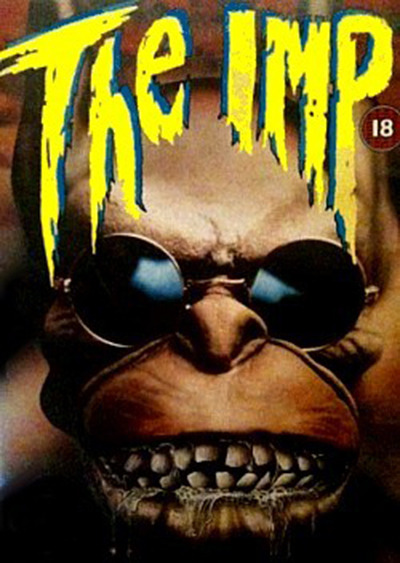
Stevens experienced her own trauma, “dealing with another actress who clearly felt threatened by me and spared no punches while shooting our fight scenes. She pushed me down so hard, I dislocated my knee, which I had to pop back into place myself.” DeCoteau recounts, “It wasn’t pretty. She had to take four days off, but was a trouper…did her job without complaint.”
Flying furniture and torn ligaments notwithstanding, the set was infused with a party panache. “It’s the only film I’ve directed where I was continuously drunk,” chuckles DeCoteau, “— many people were! It had an open bar that we put to good use.”
“It’s one of my favorite films,” says Quigley, “because I played a tough girl and kept my clothes on. It’s fun to be mean.”
Charlie’s father, Albert Band, head of production at Empire, startled DeCoteau by insisting that nudity, playfully performed for slapstick scenes, “must” be trimmed from the director’s cut of the movie. DeCoteau, realizing nudity is a commercial exponent of the exploitation formula, appealed to Charles Band. Band inquired about the running time that was assembled for the movie’s rough cut. “I told him we were well under 80 minutes,” said DeCoteau, “When I shoot a picture, rarely does the final footage pass the 80-minute length. So they can’t do much editing because a feature-length film shouldn’t run that short. As a result, Charlie told me to put the nude scenes back in.”
Band retitled the picture SORORITY BABES IN THE SLIMEBALL BOWL-A-RAMA (according to DeCoteau, Band had wanted to make it BITCHIN’ SORORITY BABES … ) and released it theatrically through Urban Classics on a double bill with GALACTIC GIGOLO (originally titled CLUB EARTH), directed by Gorman Bechard.
Like DeCoteau, Bechard was another Band discovery whose independently financed feature PSYCHOS IN LOVE was picked up by Empire for release. Unlike DeCoteau, Bechard had nothing good to say about his stint at Band’s company. “I know what it’s like to be raped, “said Bechard about producing and directing two other features for Empire.
For his next feature, PSYCHOS IN LOVE, a black comedy (a “working woman” addresses the camera with “I guess I thought me being both a manicurist and a psychotic killer would, well, turn a guy off”), Bechard chose to ally himself with Empire.
“They offered me what I thought at the time was a good advance for PSYCHOS IN LOVE,” said Bechard. “I didn’t know better. And they offered me a four-picture deal with it, as an enticement to give them PSYCHOS IN LOVE. When you’re an independent filmmaker, finding the money is the worst thing in the world, and here I was able to do four pictures and pretty much have control. Charlie Band gave me tons of wonderful promises, saying, “Well, you can come up here, assist in the editing …,’ and all these other lines of bullshit. Being basically a fellow who wanted this very badly, I believed everything he said.”
CLUB EARTH, the first of Bechard’s four-picture deal with Empire, was an omen of the discord and mistrust that would sour the relationship. Bechard conceived the movie as a social satire involving an intergalactic tourist. Empire preferred to push CLUB EARTH as GALACTIC GIGOLO, and re-edited Bechard’s original cut into their concept of a more exploitable product.
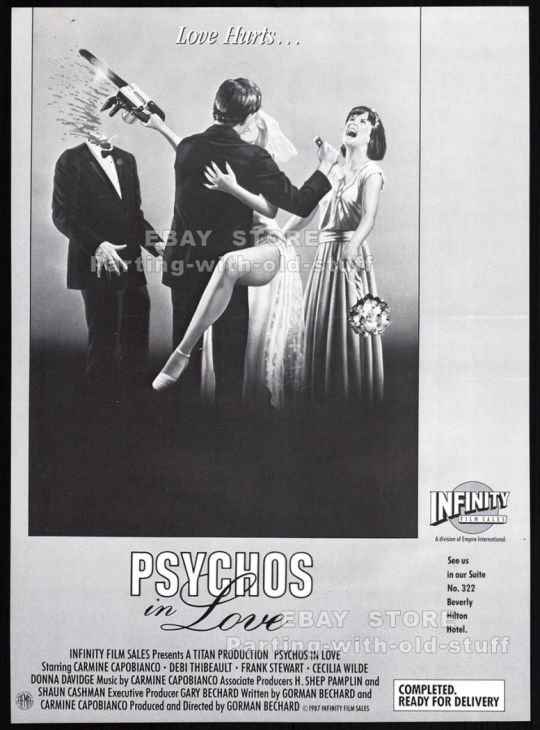
“When I gave them PSYCHOS IN LOVE, I had it in writing that they wouldn’t change it at all,” said Bechard. “If I had not done that, they probably would have raped that film and it would have never been a film that I’m proud of. I am proud of PSYCHOS IN LOVE. But I think GALACTIC GIGOLO was sodomized by Charlie Band. We filmed it as a non-animated adult cartoon. That was my concept. We used the brightest colors … I mean, every different set looked like a color cartoon frame from the Sunday paper. In [color] timing the film, [Empire] took out all of the colors and left it really flat and ugly. Their editing and pacing is nothing short of pathetic; they left out some wonderfully funny stuff, and they left in all of the shit. Their motto is ‘when in doubt, cut to a pair of tits.’ I found out that CLUB EARTH was retitled GALACTIC GIGOLO through a brochure from Empire’s Urban Classics; they never had the decency to tell me they were changing the name of my movie.”
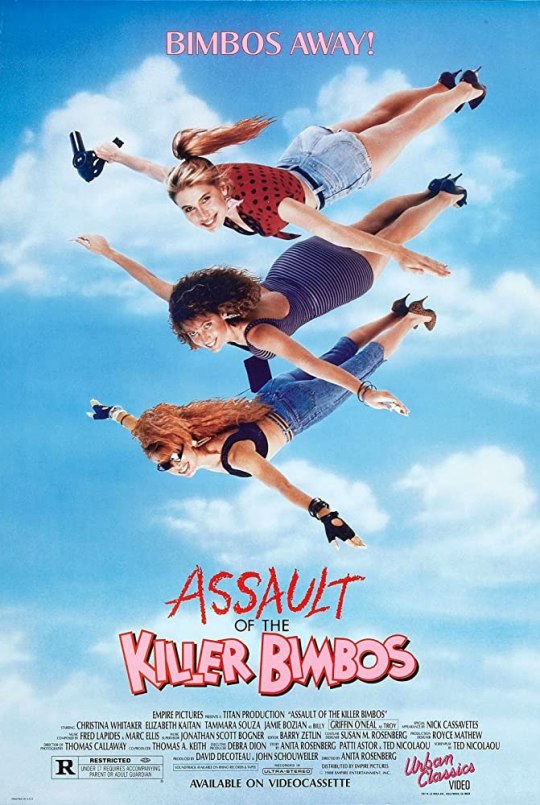
Bechard’s next film for Empire, a black comedy titled TEENAGE SLASHER SLUTS, was presold by the company in foreign markets as Assault of the Killer Bimbos (1988). “They found the word ‘sluts’ to be offensive,” said Bechard of Empire’s logic behind the title change. “And then they go and propose two other movies with the word ‘sluts’ in the title!” Empire eventually completed Bechard’s movie under the title HACK ‘EM HIGH, turning over the ASSAULT OF THE KILLER BIMBOS title to DeCoteau.
“That title presold so well, at [1987’s] American Film Market, it actually scored better than the movies in Empire’s bigger budgeted, non-Infinity division,” said DeCoteau. “Gorman Bechard completed the movie and set up a screening for Empire. It turned out to be a disappointment. Let’s just say that Gorman’s movie did not justify all of the enthusiasm. ASSAULT OF THE KILLER BIMBOS had to be brilliant, or close to it, considering the enormous presales money that was attracted from its title.”
Bechard said he deserves some of the credit for the title’s fabulous presales at the AFM, having instigated an eye-catching spread on the film in People magazine which featured Ruth Collins and Debi Thibeault, the actresses in his version. Bechard laid the blame for Empire’s dissatisfaction with the final film to the manner in which Band ran his company.
Charlie [Band] never read the script,” said Bechard. “I had the script approved by David Ross, who used to be in Empire’s development department, and by Debra Dion, who is now Charlie’s wife. I have a written letter from David Ross which says, ‘Yeh, we like the script. Just make a couple of little changes here and there.’ Basically, we agreed that it was good. Afterwards, I started filming and almost two or three weeks after we wrapped, Charlie calls me up and said he finally read the script. He said he didn’t like it. I don’t know how you run a company and allow someone to use your money to make a film without ever having read the script. That, to me, is not really the way to do business but, again, Empire is not the way to do business. When it became HACK EM HIGH, I said, ‘Wait a minute, there’s no hacking and there’s no high school.’ Of course, they came up with some new scenes that we had to reshoot which were along the lines of the usual Empire quality.”

While Empire fobbed off Bechard’s film as HACK ‘EM HIGH to foreign buyers at Milan’s Mifed Film Market, ASSAULT OF THE KILLER BIMBOS, scheduled for imminent release and eagerly awaited by distributors, existed as nothing more than a concept. Empire frantically searched for an existing script that would qualify as an adaptation of their most exploitable title.
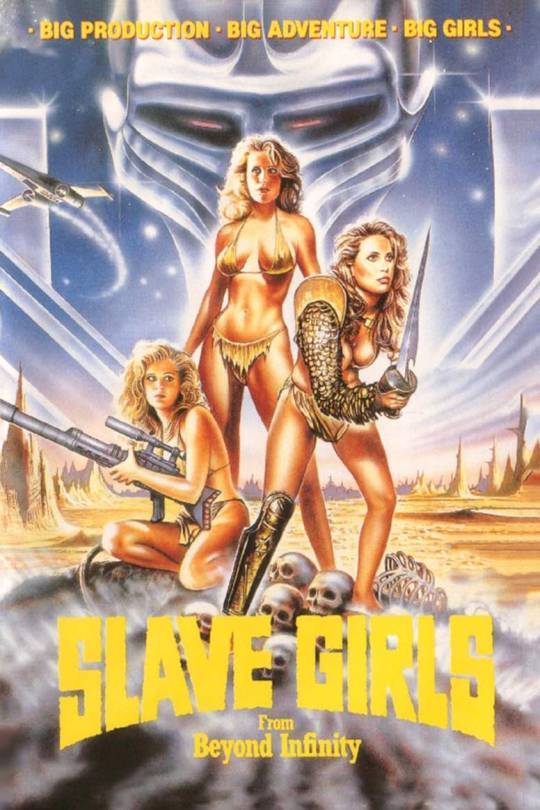
Charles Band gave up WIZARD VIDEO after he ended his deal with VESTRON. WIZARD was distributed by LIGHTENING which was owned by VESTRON and when he left that deal and went over to NEW WORLD VIDEO which then he only released one movie with them, he started a new label called URBAN CLASSICS which he would handle the physical distribution eternally. He wouldn’t do a label deal and the first released was SLAVEGIRLS and that was doing pretty well and CREEPZOIDS was doing pretty well. And they were doing okay and then they started to make these movies back in Connecticut and they were making them cheaper in Connecticut than they were here in LA. They even had a guy out in New York, Tim Kincaid, who was making movies and those weren’t that bad. But there was a guy in Connecticut named Gorman Bechard who I guess was not only producing, writing, and directing, he was the cameraman and he did lights. And he was making these 35mm movies for only $30,000. Charlie was going wow, I got this great deal. And I was saying, Charlie if you want to give me $30,000 I’ll give you $30,000 but it’s going to look like $30,000. But give me $75,000 – $90,000 and you’ll get better movies. But anyway. Gorman did his first movie and what happened was this major snafu with ASSAULT OF THE KILLER BIMBOS. It was pre-sold with huge amounts of numbers and the URBAN CLASSICS films were presented to foreign buyers as pictures made between $1-2 million. He was showing these films to people overseas after he made them to the movie here and I brought in another director, Anita Rosenberg, who at the time didn’t think she knew what she was doing. But it ended up being the best of the URBAN CLASSICS movies. – Director Dave DeCoteau on the start of URBAN CLASSICS
A serviceable script, described by DeCoteau as a “generic but cute girls-on-the run” adventure, was considered from screenwriter Anita Rosenberg, who had previously written MODERN GIRLS for Atlantic Pictures. DeCoteau postponed his preparation of Beyond Infinity’s SPACE SLUTS IN THE SLAMMER to direct the movie. Rosenberg, however, demanded complete autonomy.

Anita Rosenberg
According to DeCoteau, “Rosenberg told Empire, ‘Sure, I’ll sell you the script for 100 grand.’ I said, ‘What do you mean, 100 grand? We pay five grand per script!’ She said, “I’ll sell it to you for five grand if you let me direct it.’ I said, “What other films have you done?’ She said, ‘Nothing, though I have done a short film.’ Empire looked at her short film, thought it was adequate enough, and agreed to let Rosenberg direct it.” DeCoteau was hired as producer for “double the usual budget and triple his customary salary.
Though he was reimbursed for services rendered on GALACTIC GIGOLO and HACK ‘EM HIGH, Bechard claims he was shortchanged on the proceeds from PSYCHOS IN LOVE. “We were promised wonderful percentages of the gross, not of the net, on the film,” said Bechard. “I made sure they couldn’t pull any accounting tricks. But they did pull a great accounting trick; they just never bothered reporting to us. We were supposed to be getting quarterly statements and checks. We never got anything. My letters to Charlie Band, complaining about this situation, and the shabby treatment of my films, were ignored.”

A forthcoming documentary by Kathy Milani, B-MOVIE, traces the production of HACK ‘EM HIGH from the film’s preproduction phase to Band’s phone call alerting Bechard of Empire’s resistance to his adaptation of “a script that Band, up to that point, had not read.” Bechard promises B-MOVIE will enlighten prospective filmmakers to the hazards of low-budget filmmaking. (Milani is currently seeking completion funds and or grants.)
Meanwhile, Bechard is also exorcising his frustrations with Empire through a manual titled “Assault of the Independent Filmmaker;” as the book’s author, Bechard vowed to “paint a no holds-barred picture of the making of each of my films, from the detailed budgets to the whole filming process, to dealing with not-always reputable distributors and investors. Filmmaking is, unfortunately, the sleaziest business in the world, and it bothers me that I can’t picture myself doing anything else.”

When Empire hit the financial skids last year, some theatrical projects like GHOULIES II and CELLAR DWELLER went straight to home video while others were shelved as incomplete. For a company that in the past boasted production agendas cluttered with a dozen titles pegged as either in production “or” in preparation,” in 1988 Empire launched only one-Dave DeCoteau’s Dr. Alien (1989) (I Was a Teenage Sex Mutant), started on a budget of $400.000. The company folded before production was finished.

But Band opened up shop again late last year, calling his new operation the Bandcompany, like Empire specializing in international sales, with a video line dubbed Phantom Home Video, and a production arm called Full Moon Productions. Band’s first announced project was Edgar Allan Poe’s THE PIT AND THE PENDULUM, to be directed by Stuart Gordon. “He’s back into making pictures,” said DeCoteau. “He won’t be making as many and they won’t be as cheap.”
When Band jumped ship from Empire, his deal to sell the company gave him ownership of a trio of productions, according to DeCoteau. Band used the films, including DeCoteau’s I WAS A TEENAGE SEX MUTANT, THE INTRUDER (formerly NIGHT CREW), and JUNGLE HEAT (formerly PIRANHA WOMEN) to form his new company and subsequently negotiated a contract with Paramount Home Video for their release. I WAS A TEENAGE SEX MUTANT, now retitled DR. ALIEN!, was scheduled to be released in November.

Interview with Dave DeCoteau
Looking back on the beginning of your career, how would you appraise Dreamaniac?
Dave DeCoteau: Dreamaniac was an experiment; it was my little film school project, wrapped up in ten days. It was like learning how to do it, and learning how do it quickly, because I only had ten days to learn a career’s worth of information and make a decent movie. It was made on a $60,000 budget.
The ending of Dreamaniac-with the abrupt disclosure of a succubus as a mental patient-seems like a postproduction afterthought. Who was responsible for the cop-out compromise?
Dave DeCoteau: Me. I decided to go with kind of a triple-twist ending, just for the hell of it, since the film had nothing else to offer.
Your films have gotten even more exposure on cable TV, what with broadcasts on USA, Pay-Per-View…
Dave DeCoteau: But, you know, Creepozoids and Sorority Babes In The Slimeball Bowl A-Rama did better, during their original release, in foreign territories than domestically. We were well received in Britain. Creepozoids was number seven on the Top Ten Selling-Rental charts during the month of its release; The Untouchables was number eight! Sorority Babes, released in the United Kingdom as The Imp, did almost as good business as Creepozoids.
What’s the background of Sorority Babes In The Slimeball Bowl-A-Rama, your most unique movie?
Dave DeCoteau: Charlie (Band) wanted, a “little genie” movie to be called The Imp. I came in the next day, and read off five story lines. The fifth one was a joke, never intended to be taken seriously, about a little genie that was squished inside a bowling trophy back in the 50s and unleashed upon some sorority babes and fraternity initiates on Hell Night. Charlie liked that concept more than any of the other ones, and we decided to go with it.
There’s a frantic chase scene, near the conclusion of Sorority Babes, without music on the soundtrack. Was this intentional or an accidental omission?
Dave DeCoteau: The music channel of the entire Reel Seven did not make it to the one inch video master. When you do a final mix on a picture, you mix sound on three stripes-the dialogue, the music, and a (sound) effects track. You do the video mastering by taking your film, and your three channels of sound, and putting them onto broadcast-quality one-inch video tape for half-inch duplication. When they transferred the entire show, they accidentally forgot to drop the music channel from Reel Seven; they only transferred two channels, the dialogue and effects. The music’s omission marred the film. Fifteen or twenty-thousand copies of the tape went out without the musical channel on Reel Seven, which is the climax of the film and (originally) had an incredible musical score. I was very upset because Empire, at the time, did not let me quality control the one-inch masters. First-time viewers of Sorority Babes may prefer to hum their own theme.

Tell me where did you come up with the title SORORITY BABES IN THE SLIME BOWL-O-RAMA?
Dave DeCoteau: I didn’t come up with the title. It was shot as THE IMP and Charlie Band came up with the title. He had a little I fun to watch. The experience was a lot of fun, Making movies is never really been that much fun. The two best days of making a movie is the day you get the financing and the rap party. And everything between is a pain in the fucking ass. You always have to compromise, you can’t do exactly what you want to do. Because the budgets are so low the schedules are tight and you can’t always get the actors you want and you get the actor, you could only use him for a couple days and you can’t use him for any overtime. The process is real tough. And I think PUPPETMASTER III as being my best film in most people’s eyes but just had a horrendous time making that film.
Which of your pre-Doctor Alien (1989) films is your favorite?
Dave DeCoteau: I have to admit I have this bizarre affection for Creepozoids, I don’t know what it is, but when I was making that film I really took it deadly serious and expected it to be a lot better than it was. The reviews have been horrible, but-God!-every time I show it to somebody, they kind of, like, smile. It’s actually a serious attempt, whereas all the other films we’ve been doing seem to be a little campy or silly.
Didn’t Creepozoids get positive reviews in Europe?
Dave DeCoteau: Excellent reviews! The United Kingdom is asking for a sequel and they’re ready to cut a check to finance it. Unfortunately, I don’t have the sequel rights to that film, so I probably won’t do it.
You made some of your past films for under $200,000. What was the budget on Doctor Alien?
Dave DeCoteau: About $400,000. It’s a home video, a damn good example of direct-to-video product. I love it. It’s a very entertain. ing film for me, and everyone seems to enjoy it. The only problem about not releasing it theatrically is that it is a comedy, and comedies work very well with large audiences. I’m going to screen it for the Science Fiction Academy here, and for a few other people.
Why did you choose a more mainstream celebrity-Judy Landers-for Doctor Alien and Ghost Writer?
Dave DeCoteau: When we were casting for the Doctor Alien role of Ms. Xenobia, we wanted to go with a Mary Woronov type. Well, we auditioned hundreds of Mary Woronov, Barbara Steele and Caroline Munroe types, and we realized it just didn’t work the way it was written… it wasn’t funny. So I said, “Let’s bring Judy in for a hoot.” I just wanted to meet the girl. She came in with the scenes memorized and gave us a reading, and we were falling on the floor laughing our heads off. She played it so wonderful, and so funny, that she was perfect for the part.
With the exception of your first film, Dreamaniac, your movies have avoided the “sex begets violence” syndrome. Did you consciously reject this routine premise?
Dave DeCoteau: Yeah… women are not victims in my films. A female victim in my films is very, very rare. Women are the aggressors in my movies, they’re the ones who save the day. Look at Linnea Quigley in Sorority Babes: she never showed a nipple and she kicked ass, and she saved the day…
The History of Empire Films Part Five The rise of Empire as a low budget producer with their “Beyond Infinity” video line resembles the start-up of AIP during the drive-in boom of the late '50s, when a definite market existed for a certain product: films for the teenage audience, the wilder and more outrageous the better.
0 notes
Text
CMA Awards 2017: The Complete Winners List!
I look younger now than when I was in my early 20s
Oh what a night!
The 2017 CMA Awards have come and gone, and we loved every moment of them.
While the performances are always one of our fave parts, we do enjoy seeing which stars take home the big awards.
In case you missed seeing who won big, ch-ch-check out the winners list (below)!
ENTERTAINER OF THE YEAR
Garth Brooks - WINNER
Luke Bryan
Eric Church
Chris Stapleton
Keith Urban
SINGLE OF THE YEAR
"Better Man" – Little Big Town
"Blue Ain't Your Color" – Keith Urban - WINNER
"Body Like a Back Road" – Sam Hunt
"Dirt On My Boots" – Jon Pardi
"Tin Man" – Miranda Lambert
ALBUM OF THE YEAR
The Breaker – Little Big Town
From A Room: Volume 1 – Chris Stapleton - WINNER
Heart Break – Lady Antebellum
The Nashville Sound – Jason Isbell and the 400 Unit
The Weight of These Wings – Miranda Lambert
SONG OF THE YEAR
"Better Man"
Songwriter: Taylor Swift - WINNER
"Blue Ain't Your Color"
Songwriters: Clint Lagerberg, Hillary Lindsey, Steven Lee Olsen
"Body Like a Back Road"
Songwriters: Zach Crowell, Sam Hunt, Shane McAnally, Josh Osborne
"Dirt On My Boots"
Songwriters: Rhett Akins, Jesse Frasure, Ashley Gorley
"Tin Man"
Songwriters: Jack Ingram, Miranda Lambert, Jon Randall
FEMALE VOCALIST OF THE YEAR
Kelsea Ballerini
Miranda Lambert - WINNER
Reba McEntire
Maren Morris
Carrie Underwood
MALE VOCALIST OF THE YEAR
Dierks Bentley
Eric Church
Thomas Rhett
Chris Stapleton - WINNER
Keith Urban
VOCAL GROUP OF THE YEAR
Lady Antebellum
Little Big Town - WINNER
Old Dominion
Rascal Flatts
Zac Brown Band
VOCAL DUO OF THE YEAR
Brothers Osborne - WINNER
Dan + Shay
Florida Georgia Line
LOCASH
Maddie & Tae
MUSICAL EVENT OF THE YEAR
(Award goes to each Artist)
"Craving You" – Thomas Rhett featuring Maren Morris
"Funny How Time Slips Away" – Glen Campbell with Willie Nelson - WINNER
"Kill A Word" – Eric Church featuring Rhiannon Giddens
"Setting the World on Fire" – Kenny Chesney with P!nk
"Speak to a Girl" – Tim McGraw & Faith Hill
MUSIC VIDEO OF THE YEAR
"Better Man" – Little Big Town
Directors: Becky Fluke and Reid Long
"Blue Ain't Your Color" – Keith Urban
Director: Carter Smith
"Craving You" – Thomas Rhett featuring Maren Morris
Director: TK McKamy
"It Ain't My Fault" – Brothers Osborne
Directors: Wes Edwards and Ryan Silver - WINNER
"Vice" – Miranda Lambert
Director: Trey Fanjoy
NEW ARTIST OF THE YEAR
Lauren Alaina
Luke Combs
Old Dominion
Jon Pardi - WINNER
Brett Young
[Image via Getty Images.]
you might even get Kim Kardashian's or Paris Hilton's...
from LL Celeb Fueads http://ift.tt/2m7ABZC
via IFTTT
0 notes
Photo

Evil Laugh (1988) by Dominick Brascia.
#Evil Laugh#Dominick Brascia#1988#Steven Baio#Kim McKamy#Tony Griffin#VHS#video#eighties#'80#cover#scan#VHS ninja
58 notes
·
View notes
Text
Lunch Meat (1987): SUMMARY
Cannibals who roam the San Bernardino Mountains in search of victims! PAW & THE BOYS! BENNY, ELWOOD and HARLEY! Psychotic, meat-eating mutilators who get their kicks by ambushing young men and women, hunt them down, and cold-bloodedly. tear their bodies apart!
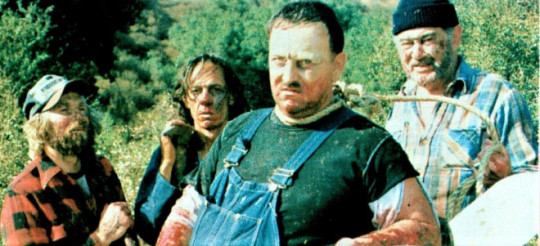
There’s HARLEY, who get his kicks by chopping off people’s heads with his AXE! There’s ELWOOD, his younger brother, who likes to DRILL HOLES in his victims with his PICKAXE! PAW’S favorite tool is his stainless steel MACHETE! He gets his thrills by tracking his prey down, taking a couple of swipes with the machete to draw BLOOD, and then likes to see them beg for mercy. He’ll move in with a chuckle and CHOP THEM UP into many pieces of BLOOD-DRENCHED MEAT and BONES to be thrown in TRASH BAGS and taken down to the nearest greasy spoon to be sold as lunchmeat!!!! Then there’s BENNY! Deaf and dumb and MANIACAL with an insatiable thirst for human blood and raw flesh!!!! BENNY does his best work with a shovel!!!!
BEHIND THE SCENES/PRODUCTION
The film is the culmination of three years work and a virtually lifelong dream of its 39 year-old writer/director Kirk Alex. With a background that includes film school training, Alex had been making his living driving a cab. Eventually the frustrations of that job, and the passion to make movies, overrode the instinct to make a living and he sold his cab to raise the money to start filming LUNCH MEAT.
Alex is understandably reticent about discussing details that might affect the film’s value on the marketplace but it seems likely that it was shot on 16mm with a budget probably below $60,000. The film was made on a 14 day shooting schedule, most of which was haphazardly scattered over an almost three month period. “We’d shoot a couple of days here, a couple of days there,” recalled Alex. “Sometimes we’d stop because we ran out of film and had no money to buy more. Other stoppages were for schedule conflicts for cast or crew. The worst delays were for hassles from the law.”
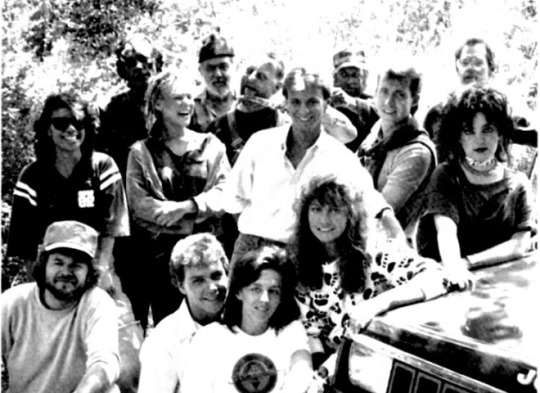
Cast & Crew
Alex’s cast and crew frequently had to change filming locations due to run-ins with Southern California police or Forest Rangers. “The whole system is set up for big budget productions,” complained Alex. “If you’ve got a movie camera in your hand you’ve got to have a permit to breathe, and everybody is out to make a buck off you. I was supposed to have a police officer and a fire marshal on the set at all times, at $40 an hour. A piece! There’s city, state, and county permits you’ve got to have, insurance and lawyers and paramedics. I could have spent my entire budget without ever exposing a foot of film!”
Instead Alex opted for true outlaw filmmaking. He and his group would shoot in one location until the forces of the law showed up. They would feign ignorance of the rules and regulations and then leave, promising to return with the proper paperwork and cash. In reality they would simply move on to the next suitable location and go through the whole process again.

Surprisingly, few of the film’s problems arose from the cast. “They were all pros,” said Alex. “It was 95° to 100° every day we shot and they spent most of their time running around or falling down in the dirt. Sure, they complained, but they all kept showing up and doing their best.”
Chuck Ellis, who portrays the gargantuan, cannibalistic mute Benny, was the only member of the cast whom Alex knew before shooting. “I always knew Chuck was a fine actor, and his size creates an undeniable screen presence,” said Alex. “I think he did a great job as Benny. He manages to create some sympathy for this pathetic sub-human even while we’re watching him engage in some pretty barbaric acts on screen.”
One staple of low-budget exploitation films that LUNCH MEAT lacks is sex or nudity. “It wasn’t a conscious decision to leave it out,” said Alex. “I just didn’t see any place for it in the script and I wasn’t going to bring the entire film’s pace to a halt just to have some girl take her top off.” The film’s special effects, the backbone of any gore film, also suffered for the lack of time and money. “A lot of good effects sequences were dropped because they were just too time-consuming, or costly,” recalled Alex. “I think Lori Drucker and her effects crew did a real good job on the throat ripping that kicks off the crazies’ attack, and on the miscellaneous body parts. They could have done even more. It’s the classic story: all we needed was time and money.”
Post production of the film was even more protracted than its filming. Over eight months, in increments of a day here, a day there, were spent before the final project was ready to market. Many of the delays were in order to raise additional money to deal with the next phase of the postproduction chores.

Alex bypassed any thoughts of theatrical exhibition and shopped the film around to various video distributors. He had several offers, some of which appeared more lucrative than those of Tapeworm Video, but he felt he could trust its owners because they were struggling dreamers like himself. To date, LUNCH MEAT has sold over 2500 copies for Tapeworm. That’s a pittance in comparison to the hundreds of thousands of copies a blockbuster title might move, but it’s not bad for an unknown film, with a no-name cast. It is, in fact, Tapeworm’s top seller to date.
And hopes are high that things may get better still. The tape’s incredibly graphic cover, offering a wild-eyed Benny gnawing on a severed human arm, was an undeniable eye catcher but has proven too bold for many video stores. A new, tamer cover was eventually offered.
youtube
CAST/CREW
Directed/Written
Kirk Alex
Produced by
Kirk Alex
Mark Flynn
Al Goodrum
Robert Oland
Pamela Phillips Oland
Ashlyn Gere (credited as Kim McKamy) as Roxy
Chuck Ellis as Benny
Joe Ricciardella as Frank
Elroy Wiese as Paw
Robert Oland as Harley
Mitch Rogers as Elwood
Rick Lorentz as Cary
Bob Joseph as Eddie
Marie Ruzicka as Debbie
Patricia Christie as Sue
Ann McBride as Waitress

Slaughterhouse (1987): SUMMARY
Lester Bacon is an old nut-case farmer living with his simple-minded, obese son Buddy. Both of them lament the fate of the old skilled hog farmer, now giving way to modern factory-type slaughterhouses. The father and son go on a killing spree against people who trespass on their property. In the opening scene, Buddy kills two teenagers, Kevin and Michelle, who are having some time alone in their car on a remote area of Lovers Lane.
The next day, Harold – Lester’s attorney, along with his law partner Tom and the local police chief, Sheriff Borden, visit Lester at his house to offer him $55,000 to buy his property, along with the closed-down slaughterhouse next door. Lester is told that the demolition of the slaughterhouse would create employment opportunities for many people in town, as well as get the county tax assessor off his back. Lester grumbles about Tom’s equipment and bad meat and says that he could do better with his hands, knives and fewer men. The sheriff tells Lester that the assessor’s office is foreclosing his property and he has 30 days to vacate it.

Meanwhile, Liz – Sheriff Borden’s teenage daughter – is with a group of high school friends planning to shoot a “horror video” and suggests that the area around the Bacon Slaughterhouse would be perfect. Her friends – Skip, Annie, and Buzz – wonder the whereabouts of Kevin and Michelle. Back at Lester Bacon’s property, his son Buddy takes Lester to a room and shows him the dead Michelle and Kevin. Lester is a bit unsettled, thinking that they’re neck-deep in trouble, but he tells Buddy that Tom, Harold, and Sheriff Borden deserve such a fate.
Deputy Dave, after being informed by the worried parents of Michelle and Kevin, checks out the docks and then goes to the slaughterhouse. He walks inside and calls for the two teenagers. As Dave finds a dead hanging cat, Buddy appears and kills him by shoving large metal sliding door on Dave’s gun-toting hand, chopping it off.
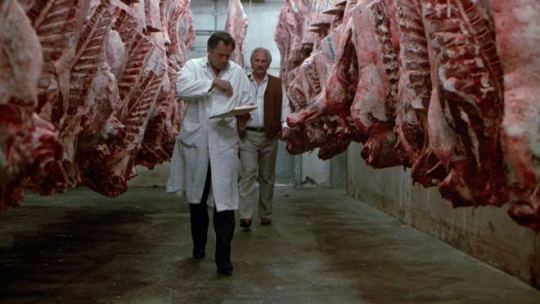
Lester then calls Harold to tell him that he has accepted his sales offer. Harold goes to the slaughterhouse where both Lester and Buddy kill him. Buddy then puts on the dead Dave’s blood-stained police uniform and goes for a drive in the squad car. Dave’s girlfriend, Sally, sees him driving past and waves, but Buddy chases her and runs her car off the road. She tries to escape on foot, but Buddy catches up to her and slices her neck with a butcher knife. When Tom arrives at the slaughterhouse, Lester lures him to the processing room, where Buddy drops him into a saw machine.
That evening at the Pig Out, a town dance, the power goes out due to a rainstorm, and many people leave. Buzz says it’s the best time for filming at the slaughterhouse. Skip then makes a $20 bet that the girls cannot last one hour at the slaughterhouse. Liz and Annie are dropped off at the place while the boys are sneaking around with masks used in Liz’s video. Elsewhere, Sheriff Borden finds Sally’s car with the damaged windshield and Dave’s patrol car with the door open. The sheriff then goes back to his car and calls for backup.
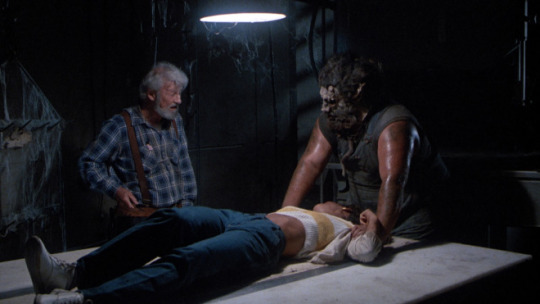
Back at the slaughterhouse, Liz and Annie realize that the boys are outside trying to scare them. Liz looks for a way to get behind the two guys and scare them instead. The boys split up and Buzz gets inside the building. Skip is at the window, and Annie laughs until Buddy suddenly appears and whacks Skip. Annie screams and runs, but Lester appears and grabs her.
Liz walks to the front door and sees that everyone is gone. At the same time, Buzz walks into a room, hears a noise and gets hit in the face by Buddy. Liz finds a hanging Annie (still alive), as well as the dead bodies of all the other victims. The father-son duo is there and Buddy grabs Liz. Meanwhile, Sheriff Borden learns that Tom and Harold have mysteriously disappeared.

Buddy and Lester hold Liz down on a table, and Lester says that a meat cutter like himself and Buddy have the skills like a surgeon. Lester slices one of Liz’s fingertips to prove to her that it is one of the most sensitive parts of the human body. When Lester turns and hears Sheriff Borden enter through the front door, Liz kicks Lester and runs away. She finds her father and runs to him. Buddy appears and the sheriff tries to shoot him, but he hits the blade of his meat cleaver. Sheriff Borden and Liz run outside into the rain. As Sheriff Borden pauses at his squad car door, Lester appears and stabs him in the back. Liz picks up her father’s gun and shoots Lester. She then helps the wounded sheriff into his car. She also gets the keys to start up the car, just as Lester rises and knocks at the car windows. She turns around, shifts the car into reverse, and runs over Lester, crushing his head and finally killing him. The sheriff tells Liz to drive away and radio for help. Buddy suddenly sits up from the backseat and swings his knife at Liz. She screams, and the film suddenly ends.
youtube
BEHIND THE SCENES/PRODUCTION
Even before the new slasher movie Slaughterhouse played in its first commercial theater, it was in the black. Slowly squealing its way around the country, the film was a testament to the new Hollywood, where independent companies outnumber major studios eight to one, and where home video and foreign sales can more than pay for a film’s cost. Slaughterhouse, for example, was sold to 60% of the foreign markets, including Germany, England, and Japan, before its domestic fate had been determined. Embassy’s Charter Entertainment is distributing the video cassette
It helped that the movie was made on a very tight budget; in fact, only fifteen full-time crew mcmbers were employed. As a result, writer director Rick Roessler was faced with the task of making up credits to increase the film’s prestige. The first two weeks of a four-week shot were done without any days off. and at that point, Roessler joked, they had to pick a few people off the floor and take some time off.
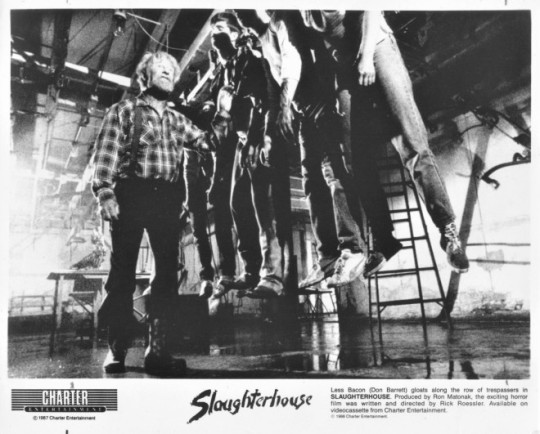
The film marks a major launch for American Artists, in which Roessler is one of three partners. The San Diego-based production company was set up four years ago primarily to produce films. The partners proceeded to work on other people’s movies until they could raise enough capital, mostly from private investors, for their own venture.
They even wanted to distribute the movie themselves, but felt they were not adequately prepared for such a challenge. Instead, they gave that job to Castle Hill in New York, which splits the grosses 50/50 with American Artists. “They don’t normally do horror films,” Roessler explained. “It worried me in the beginning. because I wanted to go with a company that knows horror films. New World wanted to buy it out for the ridiculous figure of $400,000.” Castle Hill’s involvement marks a continuing trend: prestigious “art house” distributors who are resorting more and more to handling low budget horror films as well. In their case, they put the name of a subsidiary on it. JGM Enterprises.
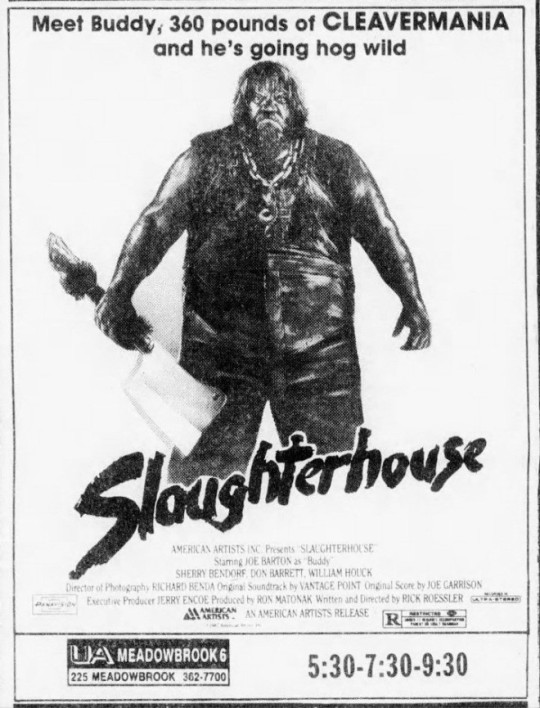
“The name of the game is you have to make a living, suggested Roessler. “I know I dug into our bank account heavily to help bankroll this film. I got into the horror genre not only because I like it but because there’s a base audience out there. Being horror fans, the one thing we didn’t want to do was absolute schlock. We didn’t want to do porn. You won’t see any gratuitous sex.”
One thing Roessler did play up was the comedy element. “We enjoy tongue and cheek stuff,” he said. “There must be a measure of comedy to make the film more horrific; otherwise, it would be too dull. Some films have so much blood, like EVIL DEAD, that they become funny.”
Roessler said he used the FRIDAY THE 13th series as an example of what he was trying to avoid. “It started out well, I think. The first one was low budget, and I think a lot of effort went into it. But look what’s happened to the character in the next five. It’s just gone blithering on they haven’t really identified who this guy is. The last one, six, was this huge slugger walking around with huge boots, whacking people for. I guess, no reason.

For Slaughterhouse Roessler developed his own character, Buddy, who in the ads is described as “360 pounds of Cleavermania” (in real life, Joe Barton, who plays him, is 372).
“With Buddy, what we tried to do was establish a character. He’s human he’s not some abstract. There’s hopefully some sentiment, some pathos in this character. Doesn’t say word one through the whole thing, and he’s the so-called star. He snorts like a pig.”
The film works as a sort of revenge picture, with Buddy killing those who provoke him or try to evict him and his father out of their condemned slaughterhouse. Thus, the title provides an ideal double entendre for the movie. The film has played in Detroit, Nashville. Denver. Washington, D.C., Pittsburgh and Phoenix, with other cities to follow. Roessler is expecting Embassy to be pleased with its release path. “Embassy put money into it because they want it to get out there. The best advertising for home video obviously is theatrical release, and the best theatrical release for home video is the one-week hit ’em and then leave, because not everybody gets to see it. The word gets around, and then they rent the video.”
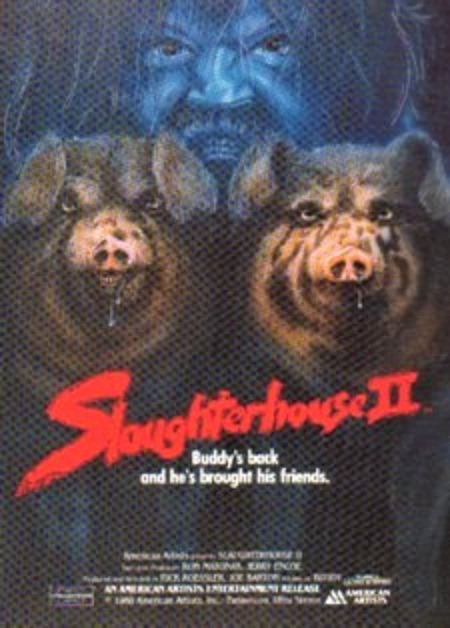
Poster for Unproduced Sequel
Roessler said raising the money to make the film, over a period of eight months, was the hardest part of getting his project on the screen. “We put on presentations for several investor parties,” he said. “We went door-to-door. We made phone calls.”
youtube
CAST/CREW
Directed/Written Rick Roessler
Produced Ron Matona
Joe B. Barton as Buddy Bacon
Don Barrett as Lester Bacon
William Houck as Sheriff Borden
Sherry Leigh (credited as Sherry Bendorf) as Liz Borden
Jeff Wright as Deputy Dave
Bill Brinsfield as Tom Sanford
Lee Robinson as Harold Murdock
CREDITS/REFERENCES/SOURCES/BIBLIOGRAPHY
Cinefantastique v19n03
Cinefantastique v18n02-03
DOUBLE FEATURE RETROSPECTIVE – Lunch Meat (1987)/Slaughterhouse (1987) Lunch Meat (1987): SUMMARY Cannibals who roam the San Bernardino Mountains in search of victims! PAW & THE BOYS!
0 notes